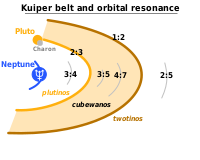Talk:Detached object
detached objects in our Solar System ? | |
| Current status: Good article | |
| This article is rated GA-class on Wikipedia's content assessment scale. It is of interest to the following WikiProjects: | ||||||||||||||
| ||||||||||||||
Daily pageviews of this article
A graph should have been displayed here but graphs are temporarily disabled. Until they are enabled again, visit the interactive graph at pageviews.wmcloud.org |
No sections?
Before this gets GA reviewed, is there really not enough content to warrant sections?
- I dunno, I mean... is there a "must have sections" requirement on ]
Buie
Looking these guys up on
- Another article [1] lists as 8:3 resonant. Other detached objects are also listed as high order resonant is this article. Ruslik (talk) 07:34, 18 July 2008 (UTC)
Buie shows 2003 UY291 as classical. But again the last observation was 2005/12/02. I am not sure how to explain this unless Lykawka used an older data set for his calculations. -- Kheider (talk) 06:24, 18 July 2008 (UTC)
new farthest member: 2006 SQ372?
read here: [2].
- Looking at the MPC's List Of Centaurs and Scattered-Disk Objects: perihelion@24AU and is under the influence of both Neptune and Uranus, so I don't think we should call it detached. When Uranus and Neptune were migrating outward, 2006 SQ372 must have had a very close fly-by of one of them.
- 2007 TG422 also comes within some influence of Neptune, but I do wonder how 2007 TG422 achieved a perihelion of 35AU with an aphelion of 900+AU. Perhaps Neptune migrated outwards to 35AU and then back inwards to 30AU. During Neptune's migration there would have been a period were Neptune had a higher eccentricity. -- Kheider (talk) 07:58, 21 January 2009 (UTC)
Hills cloud merger
My initial thought is that it may be premature to combine the two. The spherical
Trim down table?
- Emel’yanenko and Kiseleva (2008) (subscription required)

Actually that article makes the list bigger. :-) Most of the 100% resonance probability objects are simple 5:2 resonances. Some notable likely resonances are:
-- Kheider (talk) 08:56, 28 January 2009 (UTC)
C-class
In April of 2009, Marc Buie informed me that that they (the Deep Ecliptic Survey?) were "in the process of revising our classification scheme (hopefully for the better)." I have since looked at some of the objects that I have used Buie to list as ScatEXT (detached) and most are now listed as ScatNEAR. I then realized that I no longer had any idea how to properly perceive a true ScatEXT object. We need to find out how the DES or minor planet is now defining ScatNEAR/EXT objects. I honestly don't think they are using their old 2005-2006 definition. Thus, I have also lowered this article to C-class. -- Kheider (talk) 17:34, 15 August 2009 (UTC)
The DES is working on their software. Some of their links are not even currently active. I think this article might need more "peer reviewed" papers to qualify for GA level. In August I was bold and actually lowered this article from B-class to C-class. But perhaps others think it is GA level. -- Kheider (talk) 21:40, 16 September 2009 (UTC)
- I don't necessarily agree... link rot's a perennial problem, but I'm prepared to accept that those references existed when they were added, and I don't think any of them are citations for controversial facts.
I do think it's a potential GA given a bit more citing the obvious, but I'll defer to your view and add a requirement for working citations to the GA review.—S Marshall Talk/Cont 21:52, 16 September 2009 (UTC)
- Well, in GA review terms, I've asked for a clear definition of what a Detached Object is to appear in the lead. Let's see what appears? :)—S Marshall Talk/Cont 23:23, 16 September 2009 (UTC)
The Deep Ecliptic Survey references (Orbit Fit and Astrometric record) seem to up and running again and are no longer strongly in conflict with previous results. But:
- (48639) 1995 TL8 is coming up classical.
- 2006 QH181 has a good chance of being in resonance with Neptune.
- (82075) 2000 YW134 has being coming up as 8:3 resonance using DES for quite some time.
- 2003 UY291 is coming up classical.
Keep in mind that if I was to take the DES results as flawless I would have to accept a lot of objects as detached that are also classical, ie.: 20000 Varuna and Makemake. But then again, perhaps it is correct to say that all un-perturbed objects are detached. Where do we draw the line since the Minor Planet Center and Deep Ecliptic Survey define classical somewhat differently? The DES runs a 10 million year simulation, I do not know how exactly the MPC defines a classical object. -- Kheider (talk) 22:01, 4 October 2009 (UTC)
Update?
The last detached object in the list was discovered in 2006. Have there been any new detached objects discoveries since that time? --Jan.Kamenicek (talk) 12:38, 11 February 2012 (UTC)
- Yes, probably. 2012 DR30, f.ex. is somewhat interesting:
- It seems it has a large a ~1100 AU, as can be seen in the list:
- There are a few other candidates too, such as 2010 BK118 and 2007 TG422, but the trouble is that someone have to call them "detached objects" before the Wikipedia editors – we cannot just assume "they are detached objects" because of any criterion. Rursus dixit. (mbork3!) 17:22, 14 November 2012 (UTC)
Since the DES/Buie 10 million year simulation was used as a source in this article and moved to a new server in 2009 with different software libraries (gremlins), I have often wondered if the 2009 version of this list was better. -- Kheider (talk) 14:40, 9 February 2016 (UTC)
average distance
Can someone expand the table to add the semimajor axis length to the table? -- 70.24.250.235 (talk) 09:00, 29 March 2014 (UTC)


